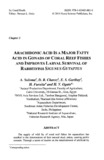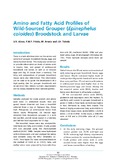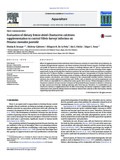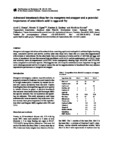Arachidonic acid is a major fatty acid in gonads of coral reef fishes and improves larval survival of rabbitfish Sigunus gutattus
Share
ບົດຄັດຫຍໍ້
The supply of wild fry of coral reef fishes for aquaculture has resulted in the deterioration of their natural stock status, causing public concern. Through a series of studies on the establishment of artificial-fry production technologies for coral reef fishes, we found that ovary, testis, eggs and fry of coral reef fishes have high or intermediate levels of arachidonic acid (ArA), which is a relatively minor component in temperate and cold-water species. In gonadal polar lipids of selected coral reef, in particular demersal fishes (19 species), ArA, eicosapentaenoic acid (EPA), and docosahexaenoic acid (DHA) levels ranged from 6.0% to 19.4%, from 0.9% to 6.2%, and from 7.9% to 27.8%, respectively. It is notable that the major highly unsaturated fatty acids (HUFA) of polar lipids in all coral reef fish gonads are DHA and ArA (not EPA) in a ratio of about 2:1. This result allowed us to speculate that not only DHA but also ArA may be nutritionally much important for egg development and larval growth in coral reef fishes.
Thus, feeding trials were conducted to investigate the effects of dietary ArA supplementation on reproductive performance of coral reef rabbitfish (Siganus guttatus) broodstock. The number of spawning and the number of hatched larvae tended to be better in broodstock fed diets with ArA than in those fed a diet without ArA. Next, larval rearing tests were conducted to investigate survival and growth in rabbitfish fry fed live rotifers which had been enriched with or without ArA. Fry fed the rotifers enriched with a combination of DHA Protein Selco (Inve Aquaculture, Baasrode, Belgium) + 5% ArA (VEVODAR CRUDE ARACHIDONIC OIL, DSM Food Specialties, Delft, the Netherlands) showed significantly the best survival (44.4 ± 4.5% for Day 17 fry), although growth was not different among treatments. The present study indicates that ArA is not a minor component in coral reef fishes, and that dietary ArA is very promising for the improvement of fry production technologies of the coral reef fishes.
Suggested Citation
Suloma, A., Chavez, D. R., Garibay, E. S., Furuita, H., & Ogata, H. Y. (2016). Arachidonic acid is a major fatty acid in gonads of coral reef fishes and improves larval survival of rabbitfish Sigunus gutattus. In S. L. Ortiz (Ed.), Coral reefs : ecosystems, environmental impact, and current threats (pp. 61-100). Hauppauge, New York: Nova Science Publishers, Inc.
ວິຊາ
Collections
Related items
Showing items related by title, author, creator and subject.
-
Amino and fatty acid profiles of wild-sourced grouper (Epinephelus coioides) broodstock and larvae
Alava, Veronica R.; Priolo, Flora Mae P.; Toledo, Joebert D.; Rodriguez Jr., Jesus C.; Quinitio, Gerald F.; Sa-an, Analyn C.; de la Peña, Milagros R.; Caturao, Romeo D. (Australian Centre for International Agricultural Research, 2004)This study was undertaken to provide information on the levels of amino acids in the muscle, liver and gonad of wild-sourced broodstock and larvae, as well as in neurula eggs and day 35 larvae from a hatchery. The fatty ... -
Evaluation of dietary freeze-dried Chaetoceros calcitrans supplementation to control Vibrio harveyi infection on Penaeus monodon juvenile
Seraspe, Ebonia B.; Gabotero, Shirleny; de la Peña, Milagros R.; Pahila, Ida G.; Amar, Edgar (Elsevier, 2014)Effects of supplementation of diets with freeze-dried Chaetoceros calcitrans to control Vibrio harveyi infection are evaluated through immune responses, and disease resistance of juvenile Penaeus monodon. Total lipid and ... -
Advanced broodstock diets for the mangrove red snapper and a potential importance of arachidonic acid in eggs and fry
Emata, Arnil C.; Ogata, Hiroshi Y.; Garibay, Esteban S.; Furuita, Hirofumi (Springer Verlag, 2003)Mangrove red snapper fed advanced broodstock diets containing squid meal and squid oil exhibited higher hatching rates, cumulative survival and survival activity index than those fed a basal diet or a basal diet supplemented ...





